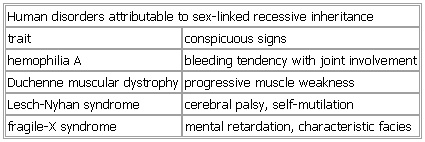Human disorders attributable to sex-linked recessive inheritance
- Human disorders attributable to sex-linked recessive inheritance
-
Human disorders attributable to sex-linked recessive inheritance
trait conspicuous signs
hemophilia A bleeding tendency with joint involvement
See as table:
* * *
Universalium.
2010.
Look at other dictionaries:
genetic disease, human — Introduction any of the diseases and disorders that are caused by mutations in one or more genes (gene). With the increasing ability to control infectious and nutritional diseases in developed countries, there has come the realization … Universalium
human disease — Introduction an impairment of the normal state of a human being that interrupts or modifies its vital functions. health versus disease Before human disease can be discussed, the meanings of the terms health, physical fitness, illness … Universalium
heredity — /heuh red i tee/, n., pl. heredities. Biol. 1. the transmission of genetic characters from parents to offspring: it is dependent upon the segregation and recombination of genes during meiosis and fertilization and results in the genesis of a new… … Universalium
connective tissue disease — Introduction any of the diseases that affect human connective tissue. Diseases of the connective tissue can be divided into (1) a group of relatively uncommon genetic disorders (genetic disease, human) that affect the primary structure of… … Universalium
Life Sciences — ▪ 2009 Introduction Zoology In 2008 several zoological studies provided new insights into how species life history traits (such as the timing of reproduction or the length of life of adult individuals) are derived in part as responses to… … Universalium
blood disease — Introduction any disease of the blood, involving the red blood cells (erythrocytes (erythrocyte)), white blood cells (leukocytes (leukocyte)), or platelets (platelet) (thrombocytes) or the tissues in which these elements are formed the bone … Universalium

